Business Research Methods: Comprehensive Analysis of Discussion Posts
VerifiedAdded on 2020/04/15
|10
|2755
|48
Discussion Board Post
AI Summary
This document presents a comprehensive analysis of several discussion posts from a Business Research Methods course. The posts delve into critical topics such as ethical considerations in research, including the concept of low or negligible risk, potential harms from ethical failures, and the application of ethical principles like autonomy, beneficence, non-maleficence, and justice. The analysis extends to mixed methods research, exploring sequential mixed methods, the benefits of triangulation, and its applications. Furthermore, the document examines grounded theory, outlining its purpose, justification, elements, and limitations, including the distinction between 'full-blooded' and 'a la carte' approaches. The document also discusses quantitative research, addressing sample size determination, random sample generation, sample stratification, model development, and the value of field studies. Finally, the document explores focus group participation, sharing personal experiences, highlighting positive and negative aspects, and suggesting improvements. It also differentiates between Leximancer and NVIVO software tools, providing examples of their appropriate uses.
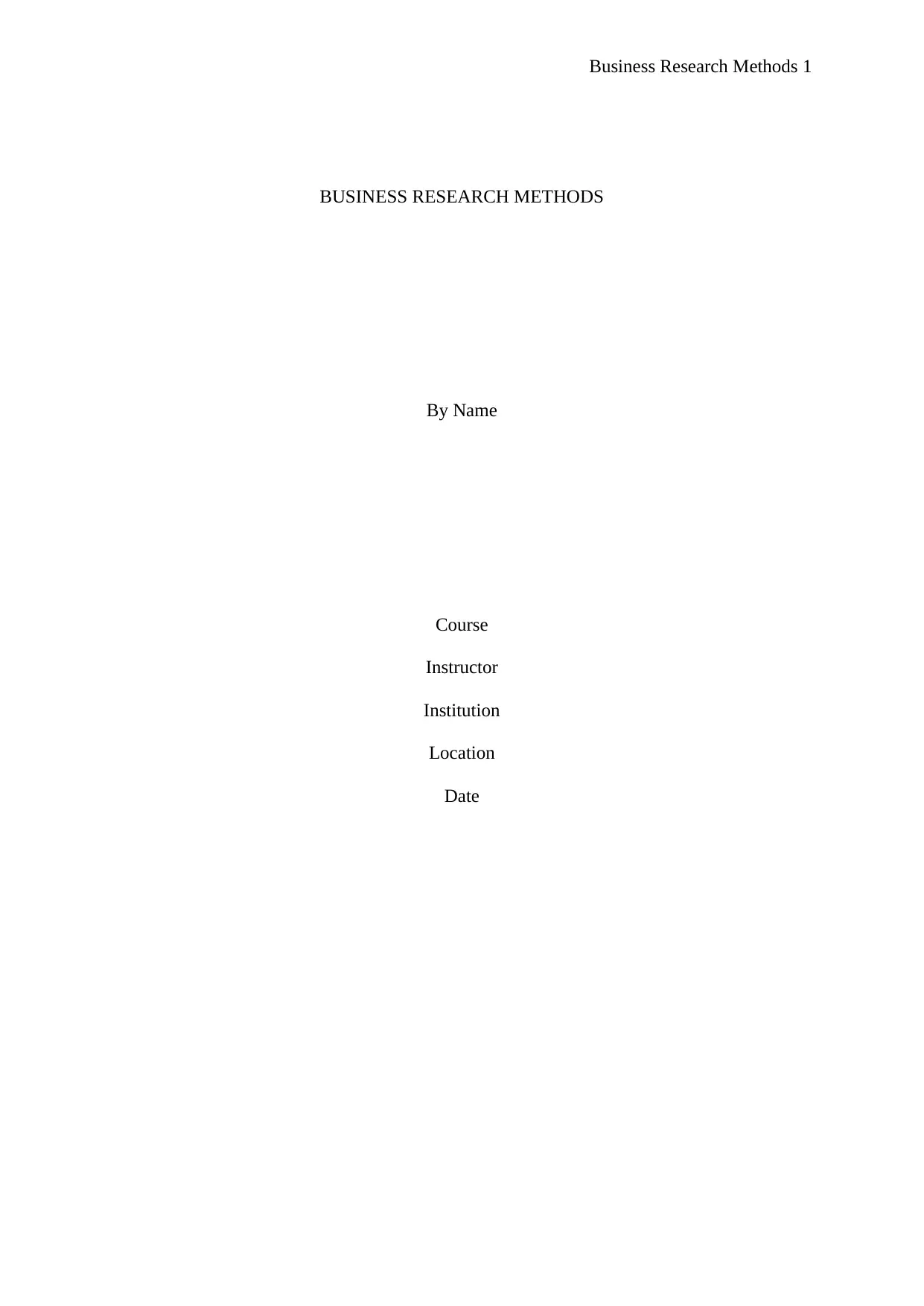
Business Research Methods 1
BUSINESS RESEARCH METHODS
By Name
Course
Instructor
Institution
Location
Date
BUSINESS RESEARCH METHODS
By Name
Course
Instructor
Institution
Location
Date
Paraphrase This Document
Need a fresh take? Get an instant paraphrase of this document with our AI Paraphraser

Business Research Methods 2
Business Research Methods
Week 3 Discussion 2: Ethics in Research.
1. What do the authors mean by low or negligible risk?
Negligible or low risk in research means that a risk of harm or any discomfort
cannot be foreseen (Bryman & Bell 2015, pp. 240). Any risk that is foreseeable is no more
than an inconvenience to those who participate.
2. What types of harm do the authors envisage might arise through failure to properly
consider ethical issues in ethical applications?
When one fails to properly, consider ethical issues in ethical applications there
is a risk that people, properties or environments can be harmed. An example is the Tuskegee
Syphilis Study. Ethical considerations have to be made to that damage of any kind is avoided.
Another harm that may occur is the use of deception to carry out studies. Lack of following
ethical procedures may also lead to a breach of the confidentiality of the people who are
participating. This may highly affect the study when participants feel violated hence the
researchers may not be able to obtain results. Plagiarism may also occur where the work of
others will be used without permission. It may also lead to the conclusions of the research
being skewed, based on funding that may have been promised prior to the study (Bryman &
Bell 2015, pp. 245). Scientific misconduct may also occur and this may have dire
consequences.
3. Discuss how the four principles of ethical conduct might apply to your research
project and steps you could take to address any issues you identify.
The principle of respect for autonomy will apply to the research, as respect has
to be there for people’s lives. Decisions made by adults should therefore not be interfered
with, in any manner while carrying out the research. The principle of beneficence will also
affect any research being done as when carrying out the study we have to ensure that all the
actions carried out are intended to bring about good. The principle of non-maleficence applies
Business Research Methods
Week 3 Discussion 2: Ethics in Research.
1. What do the authors mean by low or negligible risk?
Negligible or low risk in research means that a risk of harm or any discomfort
cannot be foreseen (Bryman & Bell 2015, pp. 240). Any risk that is foreseeable is no more
than an inconvenience to those who participate.
2. What types of harm do the authors envisage might arise through failure to properly
consider ethical issues in ethical applications?
When one fails to properly, consider ethical issues in ethical applications there
is a risk that people, properties or environments can be harmed. An example is the Tuskegee
Syphilis Study. Ethical considerations have to be made to that damage of any kind is avoided.
Another harm that may occur is the use of deception to carry out studies. Lack of following
ethical procedures may also lead to a breach of the confidentiality of the people who are
participating. This may highly affect the study when participants feel violated hence the
researchers may not be able to obtain results. Plagiarism may also occur where the work of
others will be used without permission. It may also lead to the conclusions of the research
being skewed, based on funding that may have been promised prior to the study (Bryman &
Bell 2015, pp. 245). Scientific misconduct may also occur and this may have dire
consequences.
3. Discuss how the four principles of ethical conduct might apply to your research
project and steps you could take to address any issues you identify.
The principle of respect for autonomy will apply to the research, as respect has
to be there for people’s lives. Decisions made by adults should therefore not be interfered
with, in any manner while carrying out the research. The principle of beneficence will also
affect any research being done as when carrying out the study we have to ensure that all the
actions carried out are intended to bring about good. The principle of non-maleficence applies
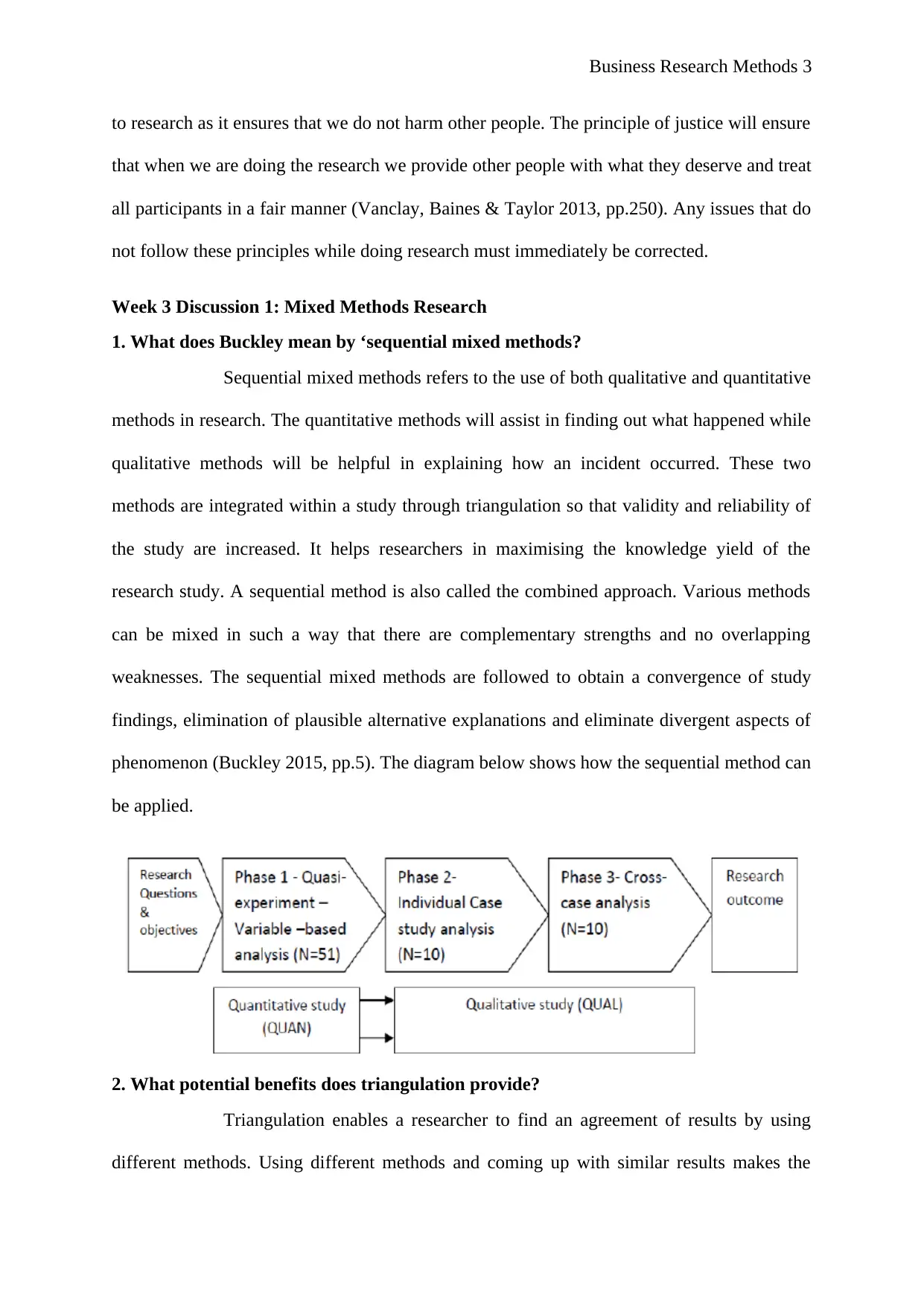
Business Research Methods 3
to research as it ensures that we do not harm other people. The principle of justice will ensure
that when we are doing the research we provide other people with what they deserve and treat
all participants in a fair manner (Vanclay, Baines & Taylor 2013, pp.250). Any issues that do
not follow these principles while doing research must immediately be corrected.
Week 3 Discussion 1: Mixed Methods Research
1. What does Buckley mean by ‘sequential mixed methods?
Sequential mixed methods refers to the use of both qualitative and quantitative
methods in research. The quantitative methods will assist in finding out what happened while
qualitative methods will be helpful in explaining how an incident occurred. These two
methods are integrated within a study through triangulation so that validity and reliability of
the study are increased. It helps researchers in maximising the knowledge yield of the
research study. A sequential method is also called the combined approach. Various methods
can be mixed in such a way that there are complementary strengths and no overlapping
weaknesses. The sequential mixed methods are followed to obtain a convergence of study
findings, elimination of plausible alternative explanations and eliminate divergent aspects of
phenomenon (Buckley 2015, pp.5). The diagram below shows how the sequential method can
be applied.
2. What potential benefits does triangulation provide?
Triangulation enables a researcher to find an agreement of results by using
different methods. Using different methods and coming up with similar results makes the
to research as it ensures that we do not harm other people. The principle of justice will ensure
that when we are doing the research we provide other people with what they deserve and treat
all participants in a fair manner (Vanclay, Baines & Taylor 2013, pp.250). Any issues that do
not follow these principles while doing research must immediately be corrected.
Week 3 Discussion 1: Mixed Methods Research
1. What does Buckley mean by ‘sequential mixed methods?
Sequential mixed methods refers to the use of both qualitative and quantitative
methods in research. The quantitative methods will assist in finding out what happened while
qualitative methods will be helpful in explaining how an incident occurred. These two
methods are integrated within a study through triangulation so that validity and reliability of
the study are increased. It helps researchers in maximising the knowledge yield of the
research study. A sequential method is also called the combined approach. Various methods
can be mixed in such a way that there are complementary strengths and no overlapping
weaknesses. The sequential mixed methods are followed to obtain a convergence of study
findings, elimination of plausible alternative explanations and eliminate divergent aspects of
phenomenon (Buckley 2015, pp.5). The diagram below shows how the sequential method can
be applied.
2. What potential benefits does triangulation provide?
Triangulation enables a researcher to find an agreement of results by using
different methods. Using different methods and coming up with similar results makes the
⊘ This is a preview!⊘
Do you want full access?
Subscribe today to unlock all pages.

Trusted by 1+ million students worldwide
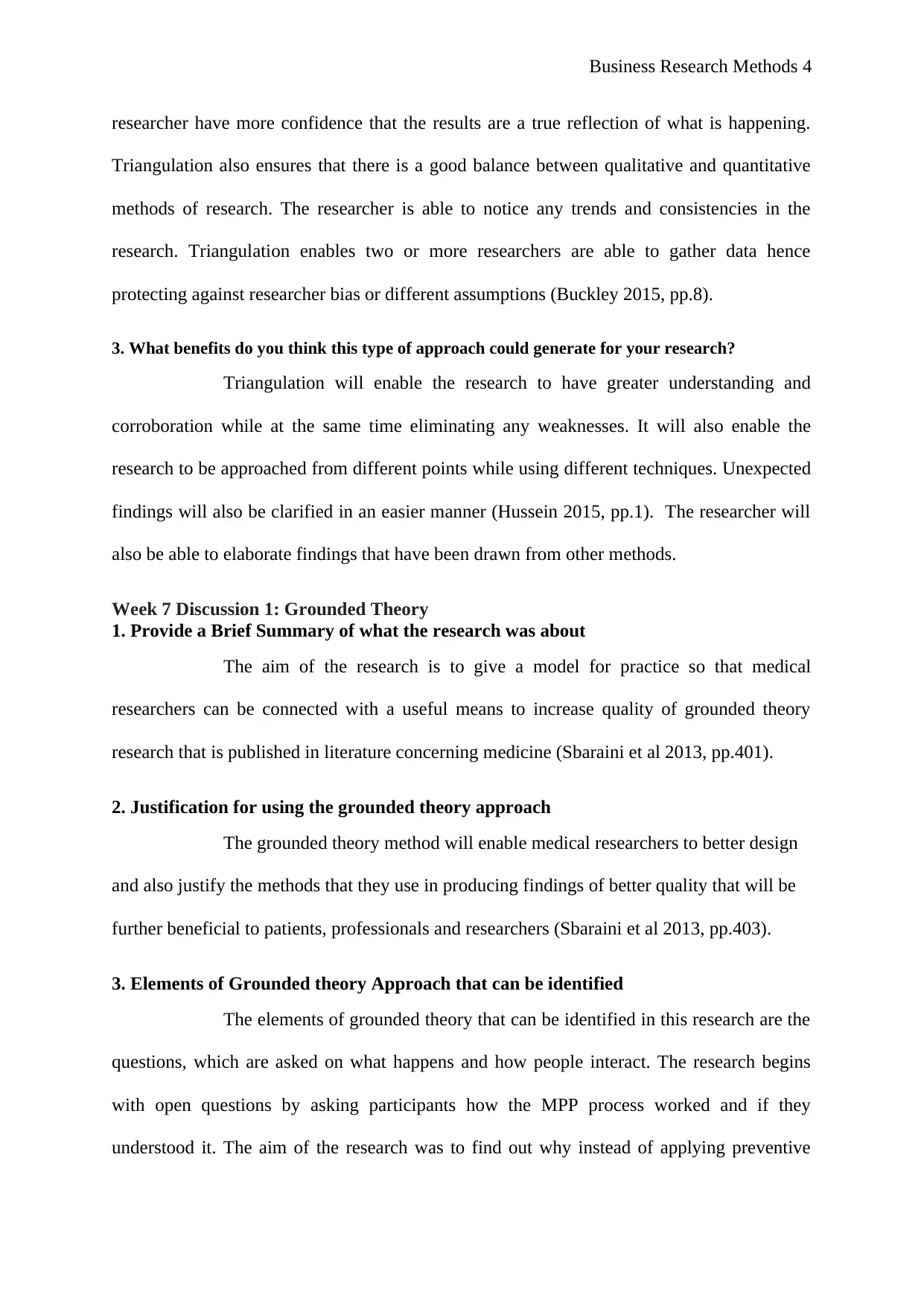
Business Research Methods 4
researcher have more confidence that the results are a true reflection of what is happening.
Triangulation also ensures that there is a good balance between qualitative and quantitative
methods of research. The researcher is able to notice any trends and consistencies in the
research. Triangulation enables two or more researchers are able to gather data hence
protecting against researcher bias or different assumptions (Buckley 2015, pp.8).
3. What benefits do you think this type of approach could generate for your research?
Triangulation will enable the research to have greater understanding and
corroboration while at the same time eliminating any weaknesses. It will also enable the
research to be approached from different points while using different techniques. Unexpected
findings will also be clarified in an easier manner (Hussein 2015, pp.1). The researcher will
also be able to elaborate findings that have been drawn from other methods.
Week 7 Discussion 1: Grounded Theory
1. Provide a Brief Summary of what the research was about
The aim of the research is to give a model for practice so that medical
researchers can be connected with a useful means to increase quality of grounded theory
research that is published in literature concerning medicine (Sbaraini et al 2013, pp.401).
2. Justification for using the grounded theory approach
The grounded theory method will enable medical researchers to better design
and also justify the methods that they use in producing findings of better quality that will be
further beneficial to patients, professionals and researchers (Sbaraini et al 2013, pp.403).
3. Elements of Grounded theory Approach that can be identified
The elements of grounded theory that can be identified in this research are the
questions, which are asked on what happens and how people interact. The research begins
with open questions by asking participants how the MPP process worked and if they
understood it. The aim of the research was to find out why instead of applying preventive
researcher have more confidence that the results are a true reflection of what is happening.
Triangulation also ensures that there is a good balance between qualitative and quantitative
methods of research. The researcher is able to notice any trends and consistencies in the
research. Triangulation enables two or more researchers are able to gather data hence
protecting against researcher bias or different assumptions (Buckley 2015, pp.8).
3. What benefits do you think this type of approach could generate for your research?
Triangulation will enable the research to have greater understanding and
corroboration while at the same time eliminating any weaknesses. It will also enable the
research to be approached from different points while using different techniques. Unexpected
findings will also be clarified in an easier manner (Hussein 2015, pp.1). The researcher will
also be able to elaborate findings that have been drawn from other methods.
Week 7 Discussion 1: Grounded Theory
1. Provide a Brief Summary of what the research was about
The aim of the research is to give a model for practice so that medical
researchers can be connected with a useful means to increase quality of grounded theory
research that is published in literature concerning medicine (Sbaraini et al 2013, pp.401).
2. Justification for using the grounded theory approach
The grounded theory method will enable medical researchers to better design
and also justify the methods that they use in producing findings of better quality that will be
further beneficial to patients, professionals and researchers (Sbaraini et al 2013, pp.403).
3. Elements of Grounded theory Approach that can be identified
The elements of grounded theory that can be identified in this research are the
questions, which are asked on what happens and how people interact. The research begins
with open questions by asking participants how the MPP process worked and if they
understood it. The aim of the research was to find out why instead of applying preventive
Paraphrase This Document
Need a fresh take? Get an instant paraphrase of this document with our AI Paraphraser
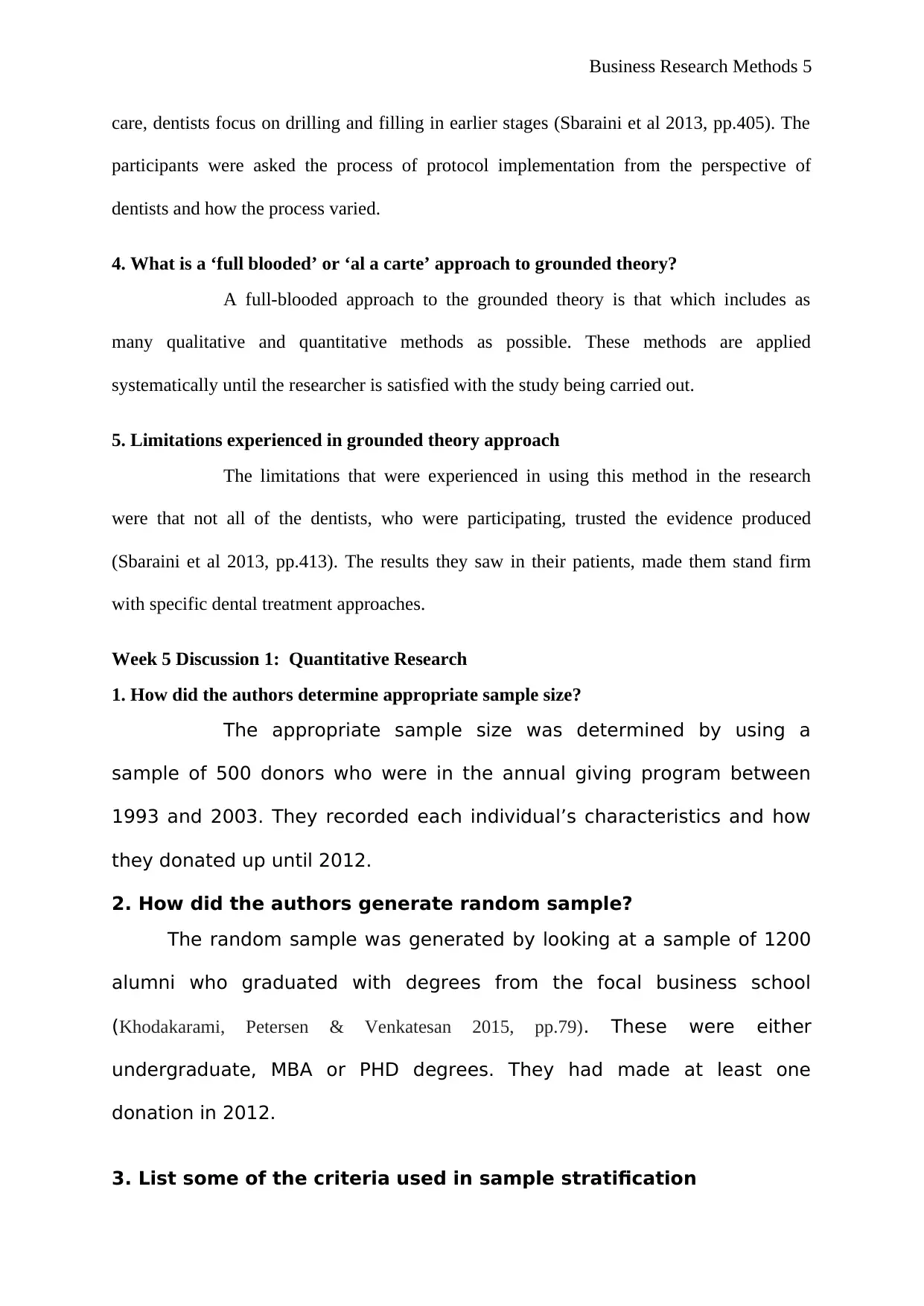
Business Research Methods 5
care, dentists focus on drilling and filling in earlier stages (Sbaraini et al 2013, pp.405). The
participants were asked the process of protocol implementation from the perspective of
dentists and how the process varied.
4. What is a ‘full blooded’ or ‘al a carte’ approach to grounded theory?
A full-blooded approach to the grounded theory is that which includes as
many qualitative and quantitative methods as possible. These methods are applied
systematically until the researcher is satisfied with the study being carried out.
5. Limitations experienced in grounded theory approach
The limitations that were experienced in using this method in the research
were that not all of the dentists, who were participating, trusted the evidence produced
(Sbaraini et al 2013, pp.413). The results they saw in their patients, made them stand firm
with specific dental treatment approaches.
Week 5 Discussion 1: Quantitative Research
1. How did the authors determine appropriate sample size?
The appropriate sample size was determined by using a
sample of 500 donors who were in the annual giving program between
1993 and 2003. They recorded each individual’s characteristics and how
they donated up until 2012.
2. How did the authors generate random sample?
The random sample was generated by looking at a sample of 1200
alumni who graduated with degrees from the focal business school
(Khodakarami, Petersen & Venkatesan 2015, pp.79). These were either
undergraduate, MBA or PHD degrees. They had made at least one
donation in 2012.
3. List some of the criteria used in sample stratification
care, dentists focus on drilling and filling in earlier stages (Sbaraini et al 2013, pp.405). The
participants were asked the process of protocol implementation from the perspective of
dentists and how the process varied.
4. What is a ‘full blooded’ or ‘al a carte’ approach to grounded theory?
A full-blooded approach to the grounded theory is that which includes as
many qualitative and quantitative methods as possible. These methods are applied
systematically until the researcher is satisfied with the study being carried out.
5. Limitations experienced in grounded theory approach
The limitations that were experienced in using this method in the research
were that not all of the dentists, who were participating, trusted the evidence produced
(Sbaraini et al 2013, pp.413). The results they saw in their patients, made them stand firm
with specific dental treatment approaches.
Week 5 Discussion 1: Quantitative Research
1. How did the authors determine appropriate sample size?
The appropriate sample size was determined by using a
sample of 500 donors who were in the annual giving program between
1993 and 2003. They recorded each individual’s characteristics and how
they donated up until 2012.
2. How did the authors generate random sample?
The random sample was generated by looking at a sample of 1200
alumni who graduated with degrees from the focal business school
(Khodakarami, Petersen & Venkatesan 2015, pp.79). These were either
undergraduate, MBA or PHD degrees. They had made at least one
donation in 2012.
3. List some of the criteria used in sample stratification

Business Research Methods 6
The researchers took stratified donor samples that fell into
one of four groups. The first group was of donors who had donated to the
business school in the past, the second group was donors who had funded
multiple initiatives including the business group and the third group was
donors who had funded other past initiatives that did not include the
business school (Khodakarami, Petersen & Venkatesan 2015, pp.80). The final group
was made up of those who funded multiple initiatives that did not include
the business school.
4. What do the authors mean by model development?
The model development that the authors did included having
model free evidence of how variety of donations can be linked to the
value of donors. The researchers used s sample of 5,500 donors for this
study. The model development also lent to quantification of the benefits
of donation variety through control of a number of factors. The
researchers came up with an econometric model to identify the
consequences of having donation variety. The researchers empirically
tested hypotheses by controlling marketing efforts, as non-profits do not
solicit for funds randomly (Khodakarami, Petersen & Venkatesan 2015, and pp.87).
Instrumental variable models were used for personal and impersonal
methods of marketing.
5. What was the value of the field study mentioned towards the
end of the paper?
The field study that was carried out in the research led to
strong causal evidence being provided and it can lead to non-profit
The researchers took stratified donor samples that fell into
one of four groups. The first group was of donors who had donated to the
business school in the past, the second group was donors who had funded
multiple initiatives including the business group and the third group was
donors who had funded other past initiatives that did not include the
business school (Khodakarami, Petersen & Venkatesan 2015, pp.80). The final group
was made up of those who funded multiple initiatives that did not include
the business school.
4. What do the authors mean by model development?
The model development that the authors did included having
model free evidence of how variety of donations can be linked to the
value of donors. The researchers used s sample of 5,500 donors for this
study. The model development also lent to quantification of the benefits
of donation variety through control of a number of factors. The
researchers came up with an econometric model to identify the
consequences of having donation variety. The researchers empirically
tested hypotheses by controlling marketing efforts, as non-profits do not
solicit for funds randomly (Khodakarami, Petersen & Venkatesan 2015, and pp.87).
Instrumental variable models were used for personal and impersonal
methods of marketing.
5. What was the value of the field study mentioned towards the
end of the paper?
The field study that was carried out in the research led to
strong causal evidence being provided and it can lead to non-profit
⊘ This is a preview!⊘
Do you want full access?
Subscribe today to unlock all pages.

Trusted by 1+ million students worldwide
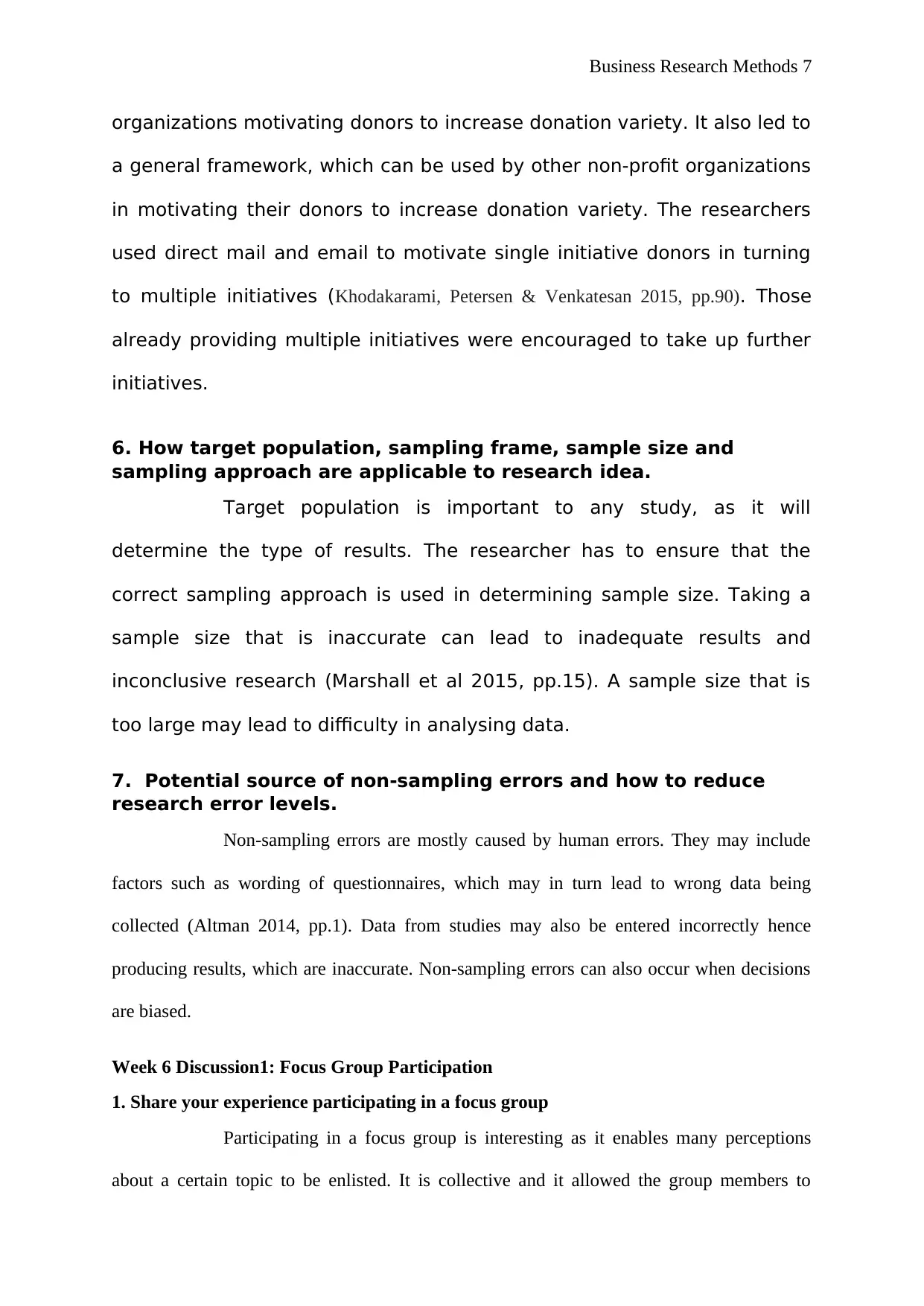
Business Research Methods 7
organizations motivating donors to increase donation variety. It also led to
a general framework, which can be used by other non-profit organizations
in motivating their donors to increase donation variety. The researchers
used direct mail and email to motivate single initiative donors in turning
to multiple initiatives (Khodakarami, Petersen & Venkatesan 2015, pp.90). Those
already providing multiple initiatives were encouraged to take up further
initiatives.
6. How target population, sampling frame, sample size and
sampling approach are applicable to research idea.
Target population is important to any study, as it will
determine the type of results. The researcher has to ensure that the
correct sampling approach is used in determining sample size. Taking a
sample size that is inaccurate can lead to inadequate results and
inconclusive research (Marshall et al 2015, pp.15). A sample size that is
too large may lead to difficulty in analysing data.
7. Potential source of non-sampling errors and how to reduce
research error levels.
Non-sampling errors are mostly caused by human errors. They may include
factors such as wording of questionnaires, which may in turn lead to wrong data being
collected (Altman 2014, pp.1). Data from studies may also be entered incorrectly hence
producing results, which are inaccurate. Non-sampling errors can also occur when decisions
are biased.
Week 6 Discussion1: Focus Group Participation
1. Share your experience participating in a focus group
Participating in a focus group is interesting as it enables many perceptions
about a certain topic to be enlisted. It is collective and it allowed the group members to
organizations motivating donors to increase donation variety. It also led to
a general framework, which can be used by other non-profit organizations
in motivating their donors to increase donation variety. The researchers
used direct mail and email to motivate single initiative donors in turning
to multiple initiatives (Khodakarami, Petersen & Venkatesan 2015, pp.90). Those
already providing multiple initiatives were encouraged to take up further
initiatives.
6. How target population, sampling frame, sample size and
sampling approach are applicable to research idea.
Target population is important to any study, as it will
determine the type of results. The researcher has to ensure that the
correct sampling approach is used in determining sample size. Taking a
sample size that is inaccurate can lead to inadequate results and
inconclusive research (Marshall et al 2015, pp.15). A sample size that is
too large may lead to difficulty in analysing data.
7. Potential source of non-sampling errors and how to reduce
research error levels.
Non-sampling errors are mostly caused by human errors. They may include
factors such as wording of questionnaires, which may in turn lead to wrong data being
collected (Altman 2014, pp.1). Data from studies may also be entered incorrectly hence
producing results, which are inaccurate. Non-sampling errors can also occur when decisions
are biased.
Week 6 Discussion1: Focus Group Participation
1. Share your experience participating in a focus group
Participating in a focus group is interesting as it enables many perceptions
about a certain topic to be enlisted. It is collective and it allowed the group members to
Paraphrase This Document
Need a fresh take? Get an instant paraphrase of this document with our AI Paraphraser
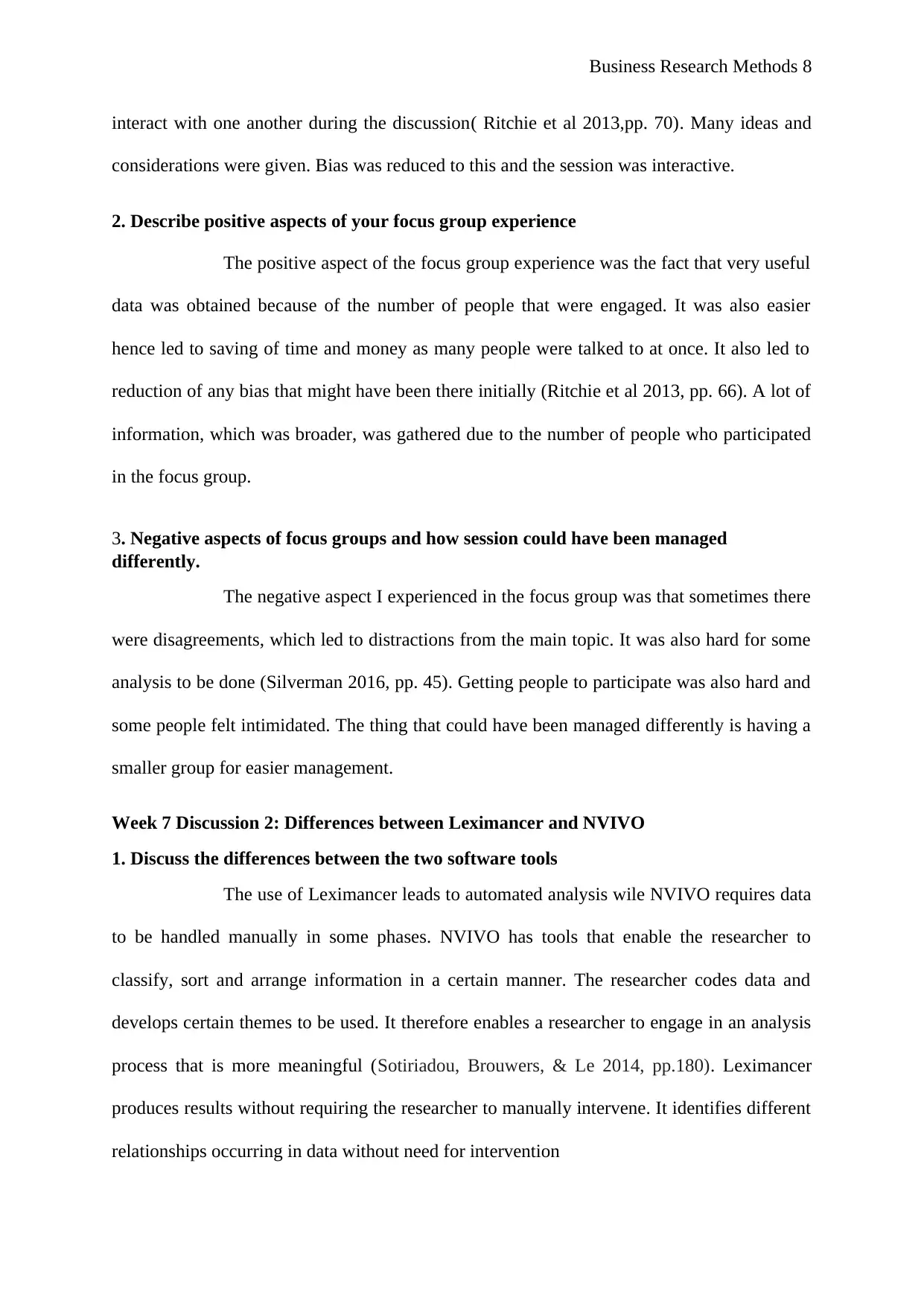
Business Research Methods 8
interact with one another during the discussion( Ritchie et al 2013,pp. 70). Many ideas and
considerations were given. Bias was reduced to this and the session was interactive.
2. Describe positive aspects of your focus group experience
The positive aspect of the focus group experience was the fact that very useful
data was obtained because of the number of people that were engaged. It was also easier
hence led to saving of time and money as many people were talked to at once. It also led to
reduction of any bias that might have been there initially (Ritchie et al 2013, pp. 66). A lot of
information, which was broader, was gathered due to the number of people who participated
in the focus group.
3. Negative aspects of focus groups and how session could have been managed
differently.
The negative aspect I experienced in the focus group was that sometimes there
were disagreements, which led to distractions from the main topic. It was also hard for some
analysis to be done (Silverman 2016, pp. 45). Getting people to participate was also hard and
some people felt intimidated. The thing that could have been managed differently is having a
smaller group for easier management.
Week 7 Discussion 2: Differences between Leximancer and NVIVO
1. Discuss the differences between the two software tools
The use of Leximancer leads to automated analysis wile NVIVO requires data
to be handled manually in some phases. NVIVO has tools that enable the researcher to
classify, sort and arrange information in a certain manner. The researcher codes data and
develops certain themes to be used. It therefore enables a researcher to engage in an analysis
process that is more meaningful (Sotiriadou, Brouwers, & Le 2014, pp.180). Leximancer
produces results without requiring the researcher to manually intervene. It identifies different
relationships occurring in data without need for intervention
interact with one another during the discussion( Ritchie et al 2013,pp. 70). Many ideas and
considerations were given. Bias was reduced to this and the session was interactive.
2. Describe positive aspects of your focus group experience
The positive aspect of the focus group experience was the fact that very useful
data was obtained because of the number of people that were engaged. It was also easier
hence led to saving of time and money as many people were talked to at once. It also led to
reduction of any bias that might have been there initially (Ritchie et al 2013, pp. 66). A lot of
information, which was broader, was gathered due to the number of people who participated
in the focus group.
3. Negative aspects of focus groups and how session could have been managed
differently.
The negative aspect I experienced in the focus group was that sometimes there
were disagreements, which led to distractions from the main topic. It was also hard for some
analysis to be done (Silverman 2016, pp. 45). Getting people to participate was also hard and
some people felt intimidated. The thing that could have been managed differently is having a
smaller group for easier management.
Week 7 Discussion 2: Differences between Leximancer and NVIVO
1. Discuss the differences between the two software tools
The use of Leximancer leads to automated analysis wile NVIVO requires data
to be handled manually in some phases. NVIVO has tools that enable the researcher to
classify, sort and arrange information in a certain manner. The researcher codes data and
develops certain themes to be used. It therefore enables a researcher to engage in an analysis
process that is more meaningful (Sotiriadou, Brouwers, & Le 2014, pp.180). Leximancer
produces results without requiring the researcher to manually intervene. It identifies different
relationships occurring in data without need for intervention
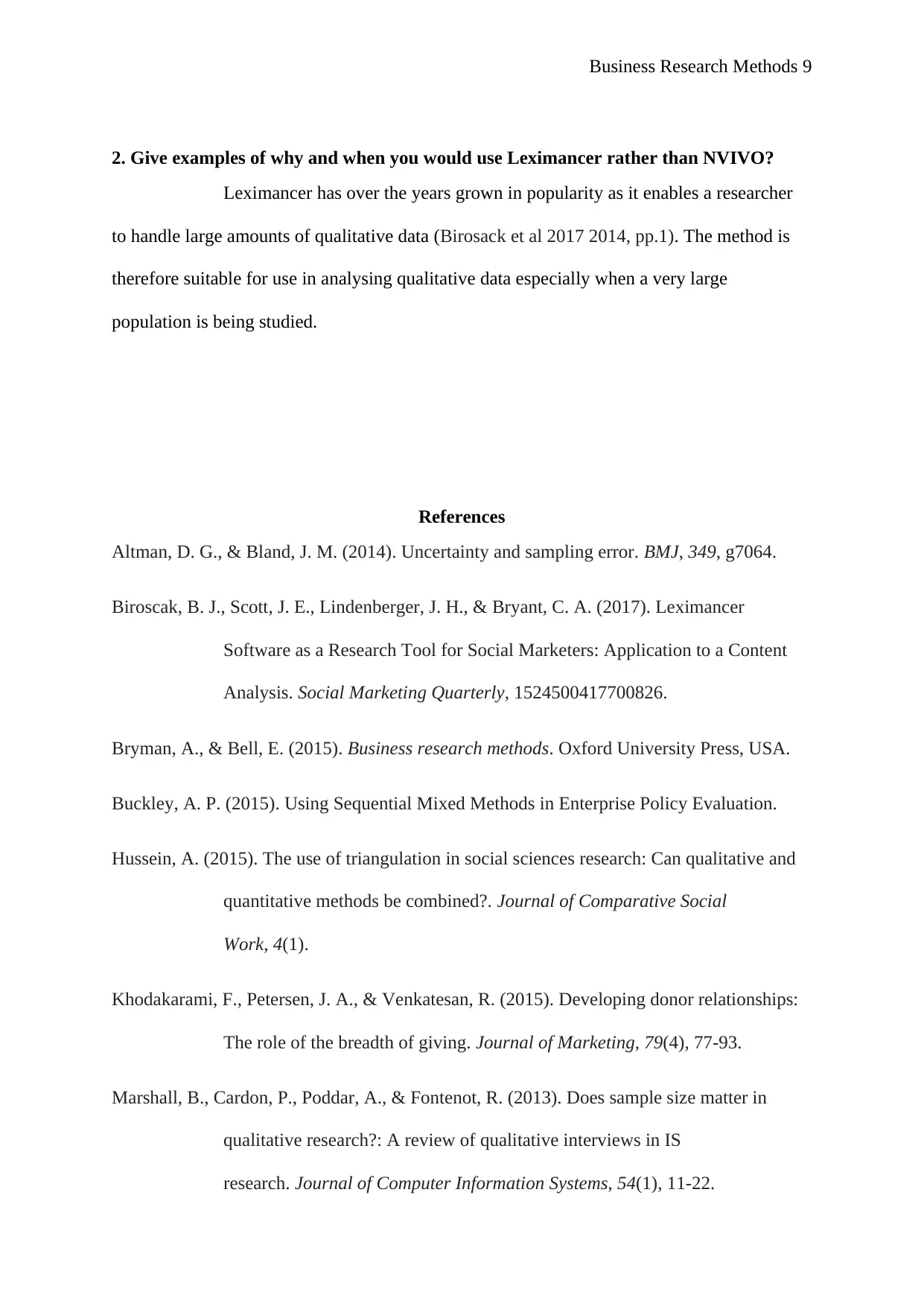
Business Research Methods 9
2. Give examples of why and when you would use Leximancer rather than NVIVO?
Leximancer has over the years grown in popularity as it enables a researcher
to handle large amounts of qualitative data (Birosack et al 2017 2014, pp.1). The method is
therefore suitable for use in analysing qualitative data especially when a very large
population is being studied.
References
Altman, D. G., & Bland, J. M. (2014). Uncertainty and sampling error. BMJ, 349, g7064.
Biroscak, B. J., Scott, J. E., Lindenberger, J. H., & Bryant, C. A. (2017). Leximancer
Software as a Research Tool for Social Marketers: Application to a Content
Analysis. Social Marketing Quarterly, 1524500417700826.
Bryman, A., & Bell, E. (2015). Business research methods. Oxford University Press, USA.
Buckley, A. P. (2015). Using Sequential Mixed Methods in Enterprise Policy Evaluation.
Hussein, A. (2015). The use of triangulation in social sciences research: Can qualitative and
quantitative methods be combined?. Journal of Comparative Social
Work, 4(1).
Khodakarami, F., Petersen, J. A., & Venkatesan, R. (2015). Developing donor relationships:
The role of the breadth of giving. Journal of Marketing, 79(4), 77-93.
Marshall, B., Cardon, P., Poddar, A., & Fontenot, R. (2013). Does sample size matter in
qualitative research?: A review of qualitative interviews in IS
research. Journal of Computer Information Systems, 54(1), 11-22.
2. Give examples of why and when you would use Leximancer rather than NVIVO?
Leximancer has over the years grown in popularity as it enables a researcher
to handle large amounts of qualitative data (Birosack et al 2017 2014, pp.1). The method is
therefore suitable for use in analysing qualitative data especially when a very large
population is being studied.
References
Altman, D. G., & Bland, J. M. (2014). Uncertainty and sampling error. BMJ, 349, g7064.
Biroscak, B. J., Scott, J. E., Lindenberger, J. H., & Bryant, C. A. (2017). Leximancer
Software as a Research Tool for Social Marketers: Application to a Content
Analysis. Social Marketing Quarterly, 1524500417700826.
Bryman, A., & Bell, E. (2015). Business research methods. Oxford University Press, USA.
Buckley, A. P. (2015). Using Sequential Mixed Methods in Enterprise Policy Evaluation.
Hussein, A. (2015). The use of triangulation in social sciences research: Can qualitative and
quantitative methods be combined?. Journal of Comparative Social
Work, 4(1).
Khodakarami, F., Petersen, J. A., & Venkatesan, R. (2015). Developing donor relationships:
The role of the breadth of giving. Journal of Marketing, 79(4), 77-93.
Marshall, B., Cardon, P., Poddar, A., & Fontenot, R. (2013). Does sample size matter in
qualitative research?: A review of qualitative interviews in IS
research. Journal of Computer Information Systems, 54(1), 11-22.
⊘ This is a preview!⊘
Do you want full access?
Subscribe today to unlock all pages.

Trusted by 1+ million students worldwide
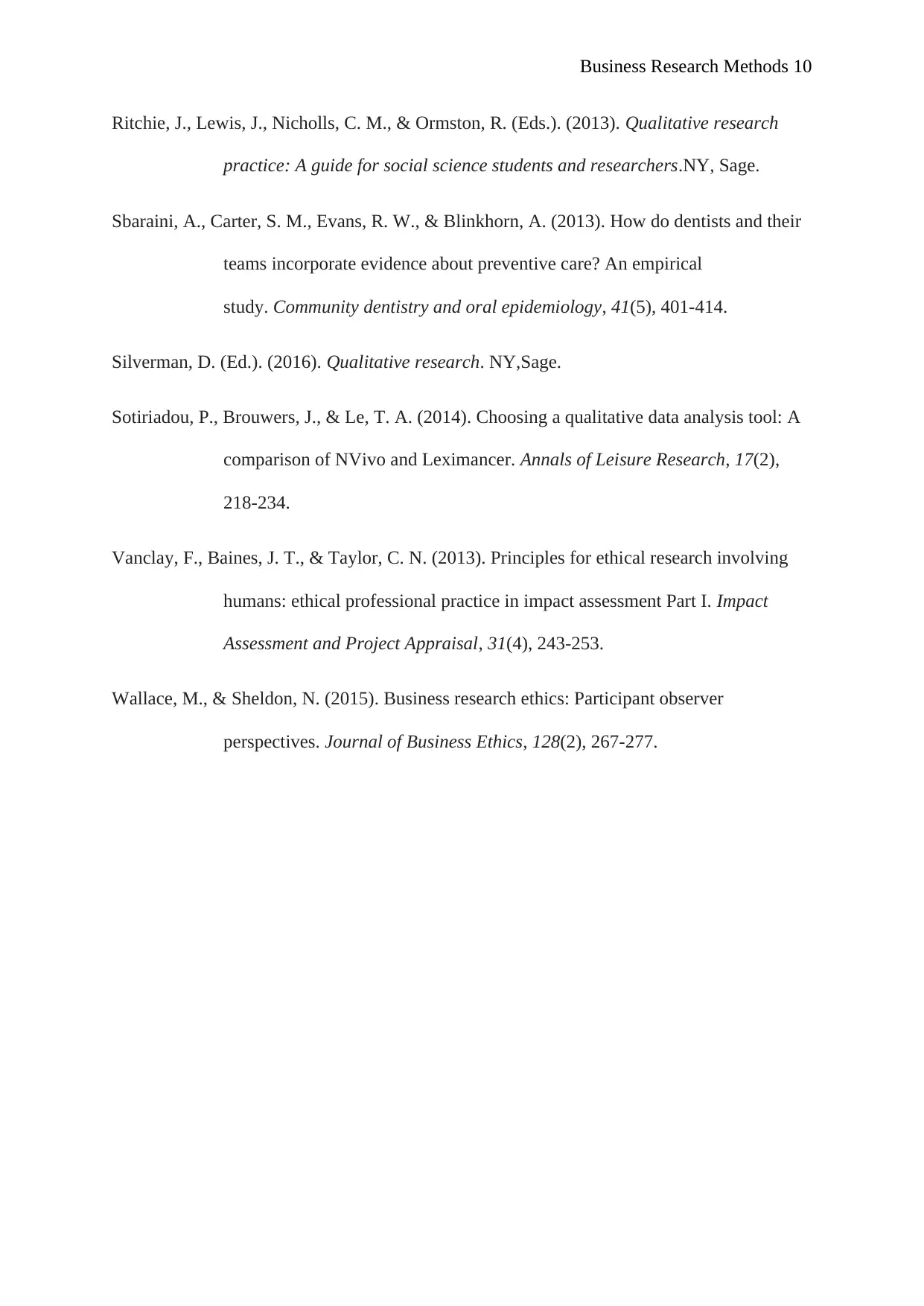
Business Research Methods 10
Ritchie, J., Lewis, J., Nicholls, C. M., & Ormston, R. (Eds.). (2013). Qualitative research
practice: A guide for social science students and researchers.NY, Sage.
Sbaraini, A., Carter, S. M., Evans, R. W., & Blinkhorn, A. (2013). How do dentists and their
teams incorporate evidence about preventive care? An empirical
study. Community dentistry and oral epidemiology, 41(5), 401-414.
Silverman, D. (Ed.). (2016). Qualitative research. NY,Sage.
Sotiriadou, P., Brouwers, J., & Le, T. A. (2014). Choosing a qualitative data analysis tool: A
comparison of NVivo and Leximancer. Annals of Leisure Research, 17(2),
218-234.
Vanclay, F., Baines, J. T., & Taylor, C. N. (2013). Principles for ethical research involving
humans: ethical professional practice in impact assessment Part I. Impact
Assessment and Project Appraisal, 31(4), 243-253.
Wallace, M., & Sheldon, N. (2015). Business research ethics: Participant observer
perspectives. Journal of Business Ethics, 128(2), 267-277.
Ritchie, J., Lewis, J., Nicholls, C. M., & Ormston, R. (Eds.). (2013). Qualitative research
practice: A guide for social science students and researchers.NY, Sage.
Sbaraini, A., Carter, S. M., Evans, R. W., & Blinkhorn, A. (2013). How do dentists and their
teams incorporate evidence about preventive care? An empirical
study. Community dentistry and oral epidemiology, 41(5), 401-414.
Silverman, D. (Ed.). (2016). Qualitative research. NY,Sage.
Sotiriadou, P., Brouwers, J., & Le, T. A. (2014). Choosing a qualitative data analysis tool: A
comparison of NVivo and Leximancer. Annals of Leisure Research, 17(2),
218-234.
Vanclay, F., Baines, J. T., & Taylor, C. N. (2013). Principles for ethical research involving
humans: ethical professional practice in impact assessment Part I. Impact
Assessment and Project Appraisal, 31(4), 243-253.
Wallace, M., & Sheldon, N. (2015). Business research ethics: Participant observer
perspectives. Journal of Business Ethics, 128(2), 267-277.
1 out of 10
Related Documents
Your All-in-One AI-Powered Toolkit for Academic Success.
+13062052269
info@desklib.com
Available 24*7 on WhatsApp / Email
![[object Object]](/_next/static/media/star-bottom.7253800d.svg)
Unlock your academic potential
Copyright © 2020–2025 A2Z Services. All Rights Reserved. Developed and managed by ZUCOL.





